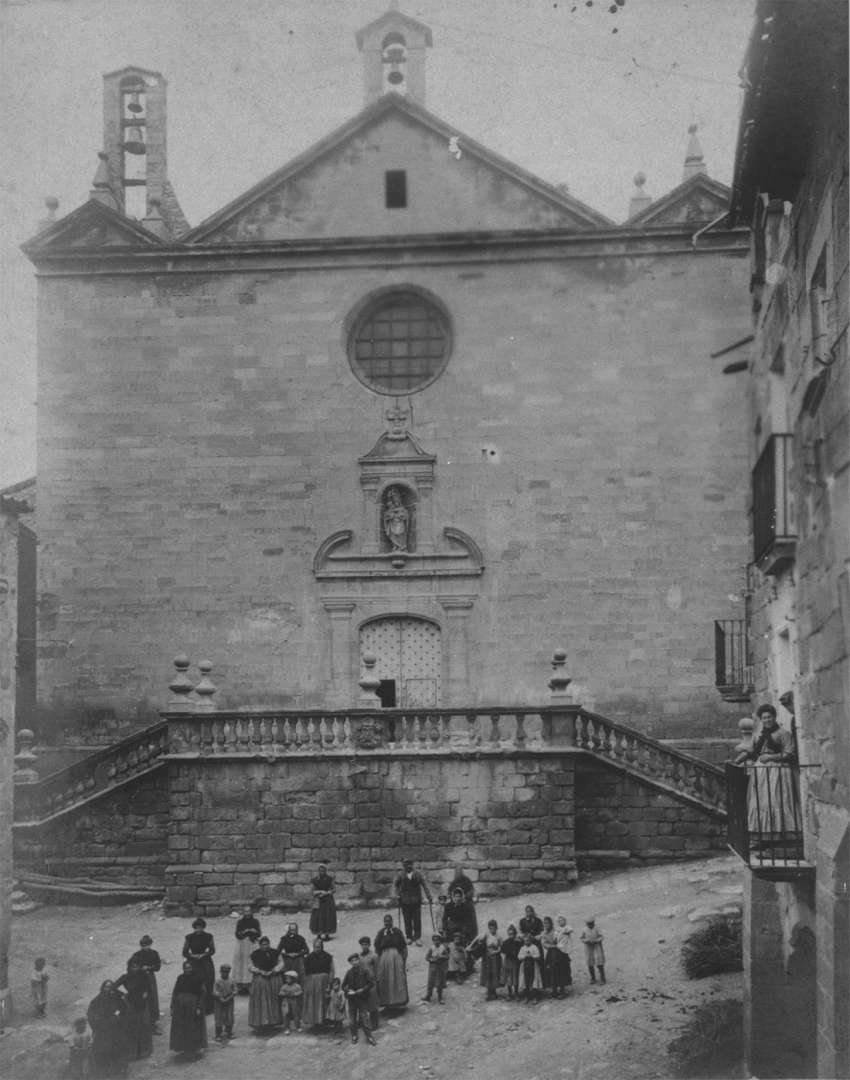Esglèsia de Sant Jaume - English
THE CHURCH OF SAINT JAMES

Dedicated to the town's patron saint, the Church of Saint James is a large neo-classical temple that dates to 1683. Although Jaume Millàs was the master builder, the church was built by Arbeca locals who worked on the construction as a public service, whether they did so willingly or were obliged to personally contribute to the public utility project. This is the largest religious building in the county of Les Garrigues, and it features a unique floor plan: the building is wider than it is long, surely seeking to take advantage of the previous structure of the Church of Saint Lucia. The church stands out for its brightly lit interior and the sober elegance of the architectural forms presided over by the High Altar. The austere baroque façade is entirely made of ashlar, unlike the side walls made of a singular stone, while the doorway, an elliptical arch, preserves the engraved date of 1686, the year in which the church opened once again.
The construction was so complex that, although the church was practically finished in 1692, work in certain spaces continued for several years. The interior stands out for the altarpiece of the Virgin Mary and the altarpiece of Saint Isidro, the chapels of the Blessed Sacrament and the Immaculate Conception, the High Altar and the baroque altar of Our Lady of the Rosary, the Renaissance-style altar of the Holy Christ, and the precious Altar of the Marys, a Renaissance style piece built for the castle chapel, the Altar of the Holy Sepulchre, life-size sculptures made with stone from the castle, and an organ with twenty registers built in 1729 that is located above the Altar of Saint Anthony. In 1784, a clock was added to the church’s façade, while the belltower was rebuilt in 1883.
With the outbreak of the Spanish Civil War (1936-1939), the church in Arbeca, like many other churches in the country, fell victim to the dismantling and destruction of religious buildings by revolutionary groups. In late July 1936, the parish temple was hit by this wave of violence when it was profaned and seized and, subsequently, employed for other uses by local authorities. The temple lost nearly all of its artistic elements, including the altarpieces, the organ, the religious images, and various pieces of liturgical furnishings, which were burned or, in some cases, disappeared. The images of the saints, decorated altars, and other elements that formed part of the church’s religious heritage were destroyed.
The church was divided into two rooms separated by an impromptu five-metre-tall partition. One room was dedicated to municipal services, in particular, the storehouse of the products from the CNT collective, while the other was designated to housing for the prisoners from work camp number 6. Despite the relative spacious location, it was difficult to fit all of them in since the number of prisoners in the work camp increased notably due to the new influx of captured soldiers. The building’s presbytery was used as an infirmary.
During the war, the church became the supply point for Arbeca’s locals who formed a long queue every morning at the main door waiting their turn to collect their ration of bread and the stew available from the Supply Delegation, which were handed out in the side chapels of the central nave by means of a ration card.
When Franco’s troops entered Arbeca on 9 January 1939, the inside of the church was dismantled. The prisoners had already been transferred to the work camp in December 1938. In early February, the youth in Arbeca were mobilized to clean up the rubble that blocked the streets where the buildings razed by the bombings were located. During that period, the wall that separated the inside of the church was also removed and the interior was cleaned. Work was carried out to recover the space as a site for worship, but many of the original artworks were lost for good.
During the following months, with the new orders given by the Nationalist Movement, the church reopened its doors for the religious functions entrusted to it. The altars, benches, and the rest of the furniture were restored little by little, funded by several wealthy families from the town and through donations collected from the parishioners. Mass and other religious rites were once again held daily, and many of them were full of blue, black, and red uniforms, especially during the first years of the post-war period.
Over time, improvements were made inside the building, the most significant of which involved the placement of the majestic altarpiece of the High Altar, dedicated to Saint James, a work by the local sculptor Jaume Perelló.
In July 1976, the church welcomed the Freedom March as it passed through Arbeca. This peaceful action demanded amnesty, basic freedoms, and the reinstatement of the Autonomous Statute of Catalan Territories promoted by the Assembly of Catalonia. Hundreds of people in Arbeca signed the statement which was read inside the church under a climate of police surveillance and repression.
As part of the celebration of the third centennial of the consecration of the church, the facades, roofs, and belltower were restored. Workers cleaned, repainted, and removed the damp from the inside of the church as well as the outdoor landing, turning it into the church that we have before us today.
